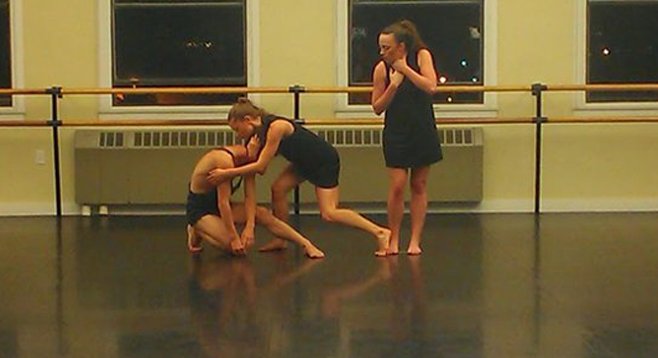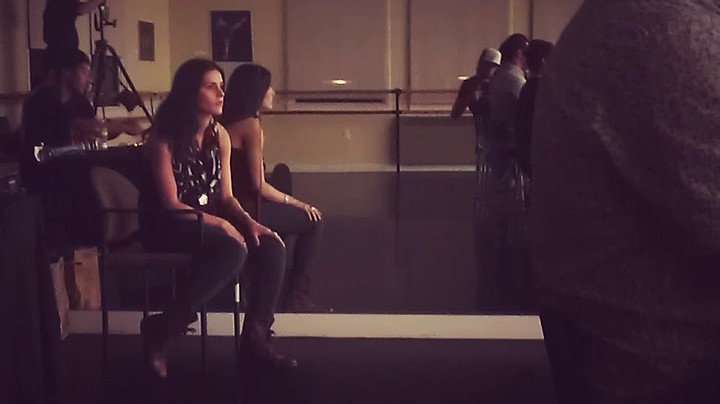 Facebook
Facebook
 X
X
 Instagram
Instagram
 TikTok
TikTok
 Youtube
Youtube

The last time Brianna Lopez danced was during the end of her studies at SDSU. Choreographing “Mind the Gap,” a short composition for four dancers, represents her first real engagement with dance in three years. The show, which had a one-night-only run at Malashock Dance in Point Loma, is a visual representation, reinterpretation, and literal coming to grips with everything that has gone on in her life since she lost touch with the art of modern dance.
Lopez says, “I haven’t performed since 2010. Once that final project ended [in September], I pretty much fell off the face of the Earth. I don’t even remember that semester. I was just sleeping. I would sleep twelve hours per night, plus whatever naps I could get during the day. It was becoming so much of an issue that I couldn’t tell if I was awake or if I was asleep. I missed my midterms and it got very intense. I don’t know what triggered this other than that I stopped dancing.
“I had to recover from that, and I was drawn to medication and that kind of stuff. I tried to finish school and move up to LA because I needed a change of scenery, and also because I was dating a guy and that would bring us together. Also, LA is kind of the birthplace of dance on the west coast.
“I pretty much abandoned all familiarity, all my networking, all my friends, all my connections. I moved with nothing at all other than a boyfriend.
“I had another type of falling out with myself that first year. It affected everything around me. I seriously thought that there was something wrong with me. That’s why I decided to go into therapy. I have been doing that for a year. [My therapist] is the one who recommended [author Brene Brown] to me. As soon as I finished my first session, I walked over to Barnes and Noble, bought the book, and started reading it that day. It only took reading the introduction for me to have an epiphany. I felt like she was speaking to me. All these ideas started coming to me and I decided to make a big change in my life. I said, ‘You know what? I’m not dancing!’ The facade of what I thought life in LA would be like...it was nothing like that! I needed to figure what I was going to do and what I had control over.
“I still knew dancers, and I still knew people at venues down in San Diego, so I pretty much abandoned my whole LA idea and came back to my roots to start this project.”
In the beginning, most of the process was discussion-based. Lopez talked about ideas of shame and its triggers with her dancers, Angelica Bell, Andrew Holmes, and Jordan Jones. Rather than simply handing down the dance moves as a choreographer, she collaborated with the dancers who would be performing “Mind the Gap.” By way of example, for the first part of the performance, the dancers created gestures that represented their own, individual understanding of the idea of shame, the battle against which forms the major theme of “Mind the Gap.”
“The point of this wasn’t to create a dance that people have seen before,” says Lopez. “I wanted to do something entirely different. Almost 50% of the dance is improvisational. There were parts where I didn’t know what was going to happen. That uncertainty and discomfort mirrors the feeling of shame.”
Sometimes, she gave the dancers vague directions, like, “I want you to have this quality of movement,” but specific steps weren’t outlined.
That explains why Lopez, during the first performance, sat anxiously at the back of the studio, watching her own choreography unfold with a look of “I hope this goes OK” on her face. After a certain point, she had to relinquish control of her own work and just let it be.

Lopez had not planned to see “Mind the Gap” performed more than the one time at Malashock. However, in the days following the performance, she’s received solicitations from studios that would like to stage the dance. Future performances are up in the air, largely for financial reasons, but also because dancer Andrew Holmes has plans to travel. Since each of the three dancers were integral parts of the creation process, replacing any one at this point seems impossible.
There’s poetry in the fact that Brianna Lopez broke a long cycle of post-artistic (and post-scholastic) depression by turning that sadness into a triumphant return to the art that she loves. Her struggle mirrors the fate of many millennials who have found themselves faced with the harsh realities of college debt, underemployment, and the crippling realization that life after college can be more horrifying than the academic advisors made it out to be. But Lopez’s story has, for now, a happy ending. She’s motivated to return to dance and pursue the dreams that had been buried beneath some serious darkness.
“I’m going to be doing a project next year,” she says. “As of now, I have two dancers who want to do it with me….I’m going to be choreographing, but I also want to dance,” says Lopez, who closes by implying that, though she has gotten herself through a lot, she still has a ways to go:
“I’m just trying to make my way through life.”


The last time Brianna Lopez danced was during the end of her studies at SDSU. Choreographing “Mind the Gap,” a short composition for four dancers, represents her first real engagement with dance in three years. The show, which had a one-night-only run at Malashock Dance in Point Loma, is a visual representation, reinterpretation, and literal coming to grips with everything that has gone on in her life since she lost touch with the art of modern dance.
Lopez says, “I haven’t performed since 2010. Once that final project ended [in September], I pretty much fell off the face of the Earth. I don’t even remember that semester. I was just sleeping. I would sleep twelve hours per night, plus whatever naps I could get during the day. It was becoming so much of an issue that I couldn’t tell if I was awake or if I was asleep. I missed my midterms and it got very intense. I don’t know what triggered this other than that I stopped dancing.
“I had to recover from that, and I was drawn to medication and that kind of stuff. I tried to finish school and move up to LA because I needed a change of scenery, and also because I was dating a guy and that would bring us together. Also, LA is kind of the birthplace of dance on the west coast.
“I pretty much abandoned all familiarity, all my networking, all my friends, all my connections. I moved with nothing at all other than a boyfriend.
“I had another type of falling out with myself that first year. It affected everything around me. I seriously thought that there was something wrong with me. That’s why I decided to go into therapy. I have been doing that for a year. [My therapist] is the one who recommended [author Brene Brown] to me. As soon as I finished my first session, I walked over to Barnes and Noble, bought the book, and started reading it that day. It only took reading the introduction for me to have an epiphany. I felt like she was speaking to me. All these ideas started coming to me and I decided to make a big change in my life. I said, ‘You know what? I’m not dancing!’ The facade of what I thought life in LA would be like...it was nothing like that! I needed to figure what I was going to do and what I had control over.
“I still knew dancers, and I still knew people at venues down in San Diego, so I pretty much abandoned my whole LA idea and came back to my roots to start this project.”
In the beginning, most of the process was discussion-based. Lopez talked about ideas of shame and its triggers with her dancers, Angelica Bell, Andrew Holmes, and Jordan Jones. Rather than simply handing down the dance moves as a choreographer, she collaborated with the dancers who would be performing “Mind the Gap.” By way of example, for the first part of the performance, the dancers created gestures that represented their own, individual understanding of the idea of shame, the battle against which forms the major theme of “Mind the Gap.”
“The point of this wasn’t to create a dance that people have seen before,” says Lopez. “I wanted to do something entirely different. Almost 50% of the dance is improvisational. There were parts where I didn’t know what was going to happen. That uncertainty and discomfort mirrors the feeling of shame.”
Sometimes, she gave the dancers vague directions, like, “I want you to have this quality of movement,” but specific steps weren’t outlined.
That explains why Lopez, during the first performance, sat anxiously at the back of the studio, watching her own choreography unfold with a look of “I hope this goes OK” on her face. After a certain point, she had to relinquish control of her own work and just let it be.

Lopez had not planned to see “Mind the Gap” performed more than the one time at Malashock. However, in the days following the performance, she’s received solicitations from studios that would like to stage the dance. Future performances are up in the air, largely for financial reasons, but also because dancer Andrew Holmes has plans to travel. Since each of the three dancers were integral parts of the creation process, replacing any one at this point seems impossible.
There’s poetry in the fact that Brianna Lopez broke a long cycle of post-artistic (and post-scholastic) depression by turning that sadness into a triumphant return to the art that she loves. Her struggle mirrors the fate of many millennials who have found themselves faced with the harsh realities of college debt, underemployment, and the crippling realization that life after college can be more horrifying than the academic advisors made it out to be. But Lopez’s story has, for now, a happy ending. She’s motivated to return to dance and pursue the dreams that had been buried beneath some serious darkness.
“I’m going to be doing a project next year,” she says. “As of now, I have two dancers who want to do it with me….I’m going to be choreographing, but I also want to dance,” says Lopez, who closes by implying that, though she has gotten herself through a lot, she still has a ways to go:
“I’m just trying to make my way through life.”
Comments